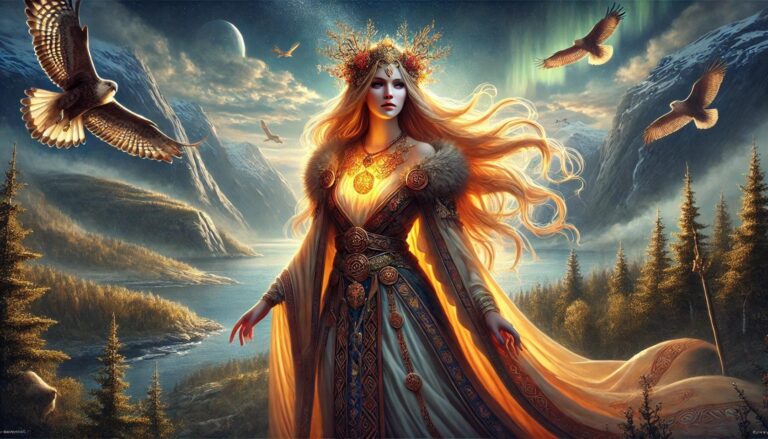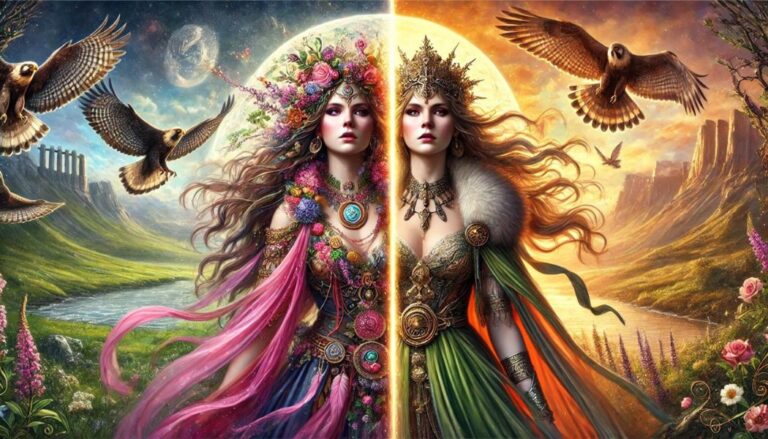An introduction to Freya, an intriguing Norse Goddess with curious family associations. Could she also be Odin’s wife, Frigg? Let’s take a look at her story.
Since moving to Norway, the tales of Norse mythology have never ceased to captivate me. Growing up in England, I knew little about the “old gods” beyond brief mentions of Odin and Thor.

But since relocating, these ancient stories have gradually revealed themselves. From the mountains that seem to whisper legends of giants, to the fjords that feel like gateways to another world, the presence of Norse mythology is everywhere.
Freya, whose name translates to “Lady” in Old Norse, is one of the most revered gods in Norse mythology. Originally a member of the Vanir gods, she later became an honorary part of the Aesir tribe after the end of the Aesir-Vanir war.
Her father is the sea god Njord, while her mother’s identity remains a mystery, though some speculate she may be Nerthus.
Freya’s family connections are intriguing—her brother is Freyr, and her elusive husband, Odr, is widely believed to be none other than Odin himself. This suggests Freya and Odin’s wife, Frigg, are essentially the same goddess under different names.
An Introduction to Freya
Known for her unquenchable thirst for love, beauty, fertility, and the finer things in life, Freya has been cast as the ultimate “party girl” of the gods. Loki the trickster god even accuses her of sleeping with all the gods and elves, including her own brother!
Yet, while Freya is undeniably a lover of pleasure, she’s far more complex than that. Freya is a master of seidr, a form of Norse magic that involves manipulating fate.
In fact, she introduced this potent form of sorcery to the gods and, later, to humans. With her vast knowledge of magic, she holds incredible power over life, destiny, and fortune.
Freya also presides over Folkvang, the afterlife realm where half of the warriors slain in battle go—a duty she shares with Odin, who claims the other half for Valhalla.

This dual role further blurs the lines between Freya and Frigg, hinting at a shared divine origin.
Freya as the Völva: The Norse Seeress
Freya embodies the völva, the wandering seeress and practitioner of magic. In the Viking Age, völvas traveled from village to village, performing rituals of seidr for food, shelter, or valuable goods.
Their power to influence fate made them both revered and feared, standing at the crossroads of respect and suspicion.
The practice of seidr involved weaving events into reality, shaping fate itself. This magic could be used for anything from healing to shaping the outcome of battles.
Freya’s role as the völva is referenced in the Ynglinga Saga and hinted at in other sagas. In one story, Freya possesses a set of magical falcon feathers that allow her (or anyone who uses them) to transform into a falcon, reflecting her mystical abilities.
Interestingly, Freya’s role as a seeress has deep roots in Germanic history. Before the Viking Age, the figure of the völva held a prestigious and necessary place in society, particularly within warbands.
The wife of the warband leader, known as a veleda, would use divination to guide warriors in battle, and her oracular powers were central to maintaining the warband’s unity.
This image mirrors the mythological role of Freya, whose magical powers were vital to the gods.
Freya & Frigg: Two Faces of the Same Goddess?
Freya and Frigg are presented as two distinct goddesses in Norse mythology, but their similarities suggest they might be different aspects of the same divine figure.

Both are linked to Odin (or Odr), both wield great influence over fate, and both have a reputation for unfaithfulness to their husband. Loki frequently accuses Freya of promiscuity, while medieval historian Saxo Grammaticus notes that Frigg slept with a slave.
In Lokasenna and the Ynglinga Saga, Frigg’s infidelity during Odin’s absence is a notable theme, further blurring the line between the two goddesses.
Both Freya and Frigg are also skilled in the art of seidr. After Loki mocks Frigg’s infidelity, Freya reminds him of Frigg’s power to see the fate of all beings, a subtle nod to her magical prowess.
Even their possessions overlap—both goddesses own magical bird feathers that enable them to shapeshift into birds of prey.
The link between the two deepens when you consider the name Freya, which simply means “Lady” and is more a title than a personal name. Meanwhile, Frigg’s name translates to “Beloved,” which is directly tied to Freya’s domain of love and desire.
Ultimately, the differences between the two are superficial, likely a product of historical evolution and the eventual Christianization of the Norse world.
While the precise reason for the split remains unknown, it’s pretty clear that Freya and Frigg are two sides of the same archetype, a powerful goddess of love, fate, and magic who played a central role in Norse mythology.

